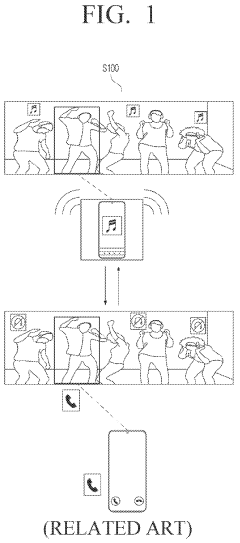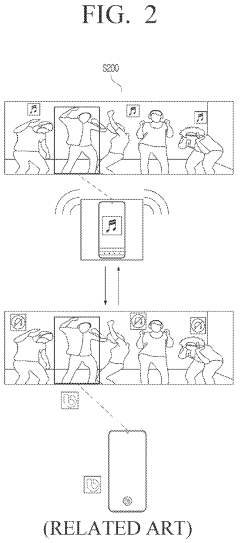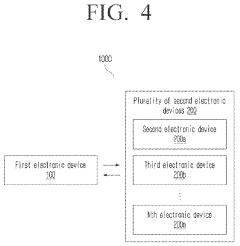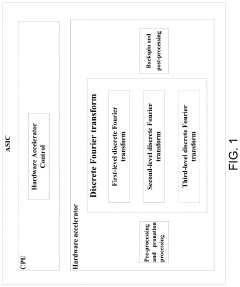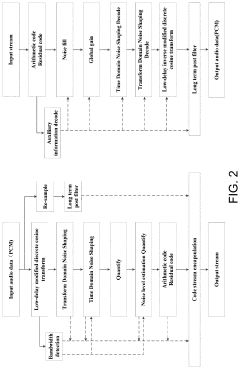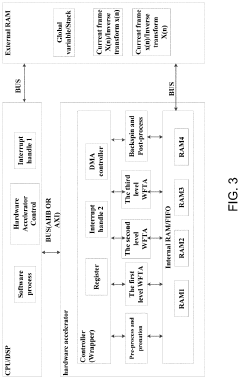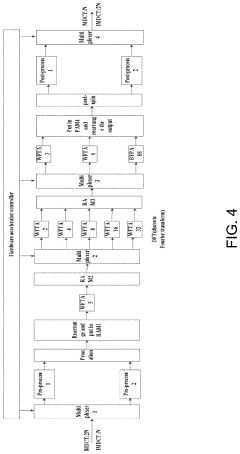LDAC for Enhanced Bluetooth Audio Experiences
JUL 4, 20259 MIN READ
Generate Your Research Report Instantly with AI Agent
Patsnap Eureka helps you evaluate technical feasibility & market potential.
LDAC Technology Evolution and Objectives
LDAC, developed by Sony in 2015, represents a significant milestone in the evolution of Bluetooth audio technology. This codec aims to deliver high-resolution audio wirelessly, addressing the limitations of previous Bluetooth audio codecs. The primary objective of LDAC is to enhance the audio experience for Bluetooth users by providing near CD-quality sound transmission over Bluetooth connections.
The technology behind LDAC has evolved from earlier attempts to improve Bluetooth audio quality, such as the Advanced Audio Coding (AAC) and aptX codecs. LDAC builds upon these foundations, offering a more sophisticated approach to audio compression and transmission. It utilizes adaptive bit rate technology, allowing it to adjust its performance based on the wireless environment and device capabilities.
LDAC's development was driven by the growing demand for high-fidelity audio in portable devices. As consumers increasingly turned to smartphones and wireless headphones for music consumption, the need for a codec that could deliver superior audio quality became apparent. LDAC addresses this need by supporting bit rates up to 990 kbps, significantly higher than standard Bluetooth codecs.
The evolution of LDAC technology has been marked by continuous improvements in efficiency and compatibility. Initially exclusive to Sony devices, LDAC has since been integrated into the Android Open Source Project (AOSP), making it available to a wider range of devices and manufacturers. This expansion has played a crucial role in establishing LDAC as a leading high-resolution Bluetooth audio codec.
One of the key objectives of LDAC is to minimize audio quality degradation during wireless transmission. To achieve this, the codec employs advanced algorithms that optimize the encoding process, ensuring that the most critical audio information is preserved. This approach allows LDAC to maintain a high level of audio fidelity even in challenging wireless environments.
Another important goal of LDAC technology is to provide a flexible solution that can adapt to various usage scenarios. The codec offers three different operation modes, each with a different bitrate, allowing users to prioritize either sound quality or connection stability based on their needs and environment. This adaptability ensures that LDAC can deliver optimal performance across a wide range of devices and conditions.
Looking forward, the continued evolution of LDAC technology aims to further bridge the gap between wired and wireless audio quality. Objectives include improving energy efficiency to extend battery life in wireless devices, enhancing compatibility with emerging Bluetooth standards, and exploring ways to reduce latency for applications such as gaming and virtual reality. As the demand for high-quality wireless audio experiences continues to grow, LDAC is poised to play a crucial role in shaping the future of Bluetooth audio technology.
The technology behind LDAC has evolved from earlier attempts to improve Bluetooth audio quality, such as the Advanced Audio Coding (AAC) and aptX codecs. LDAC builds upon these foundations, offering a more sophisticated approach to audio compression and transmission. It utilizes adaptive bit rate technology, allowing it to adjust its performance based on the wireless environment and device capabilities.
LDAC's development was driven by the growing demand for high-fidelity audio in portable devices. As consumers increasingly turned to smartphones and wireless headphones for music consumption, the need for a codec that could deliver superior audio quality became apparent. LDAC addresses this need by supporting bit rates up to 990 kbps, significantly higher than standard Bluetooth codecs.
The evolution of LDAC technology has been marked by continuous improvements in efficiency and compatibility. Initially exclusive to Sony devices, LDAC has since been integrated into the Android Open Source Project (AOSP), making it available to a wider range of devices and manufacturers. This expansion has played a crucial role in establishing LDAC as a leading high-resolution Bluetooth audio codec.
One of the key objectives of LDAC is to minimize audio quality degradation during wireless transmission. To achieve this, the codec employs advanced algorithms that optimize the encoding process, ensuring that the most critical audio information is preserved. This approach allows LDAC to maintain a high level of audio fidelity even in challenging wireless environments.
Another important goal of LDAC technology is to provide a flexible solution that can adapt to various usage scenarios. The codec offers three different operation modes, each with a different bitrate, allowing users to prioritize either sound quality or connection stability based on their needs and environment. This adaptability ensures that LDAC can deliver optimal performance across a wide range of devices and conditions.
Looking forward, the continued evolution of LDAC technology aims to further bridge the gap between wired and wireless audio quality. Objectives include improving energy efficiency to extend battery life in wireless devices, enhancing compatibility with emerging Bluetooth standards, and exploring ways to reduce latency for applications such as gaming and virtual reality. As the demand for high-quality wireless audio experiences continues to grow, LDAC is poised to play a crucial role in shaping the future of Bluetooth audio technology.
Market Demand for High-Quality Bluetooth Audio
The demand for high-quality Bluetooth audio experiences has been steadily increasing in recent years, driven by the growing popularity of wireless audio devices and the rising expectations of consumers for superior sound quality. As more users transition from wired to wireless audio solutions, there is a significant market opportunity for technologies that can deliver enhanced audio experiences over Bluetooth connections.
The global wireless audio market has been experiencing robust growth, with Bluetooth-enabled devices playing a crucial role in this expansion. Consumers are increasingly seeking wireless audio solutions that offer convenience without compromising on sound quality. This trend is particularly evident in the premium headphone and speaker segments, where users are willing to invest in products that promise superior audio fidelity.
One of the key drivers of this demand is the widespread adoption of smartphones and tablets as primary music playback devices. As these devices continue to eliminate traditional audio jacks, the reliance on Bluetooth for audio transmission has become more pronounced. This shift has created a strong need for advanced audio codecs that can overcome the bandwidth limitations of Bluetooth and deliver high-resolution audio wirelessly.
The market demand extends beyond consumer electronics to automotive and smart home applications. Car manufacturers are integrating advanced Bluetooth audio systems to enhance in-vehicle entertainment experiences. Similarly, smart home devices are leveraging improved Bluetooth audio capabilities to offer seamless, high-quality audio streaming throughout connected living spaces.
Professional audio markets, including recording studios and live performance venues, are also showing interest in high-quality Bluetooth audio solutions. These sectors require ultra-low latency and high-fidelity audio transmission, presenting opportunities for advanced technologies like LDAC to address their specific needs.
The demand for enhanced Bluetooth audio is further fueled by the growing popularity of lossless and high-resolution audio streaming services. As more consumers subscribe to these services, there is an increasing expectation for wireless audio devices to support and accurately reproduce high-fidelity audio content. This trend is pushing manufacturers to adopt advanced audio codecs and technologies that can preserve audio quality over Bluetooth connections.
In response to these market demands, there is a clear opportunity for technologies like LDAC to gain traction. LDAC's ability to transmit high-resolution audio over Bluetooth addresses a critical gap in the market, aligning with consumer expectations for wireless audio quality that rivals wired connections. As awareness of audio quality differences grows among consumers, the demand for LDAC and similar technologies is likely to increase, driving innovation and competition in the Bluetooth audio ecosystem.
The global wireless audio market has been experiencing robust growth, with Bluetooth-enabled devices playing a crucial role in this expansion. Consumers are increasingly seeking wireless audio solutions that offer convenience without compromising on sound quality. This trend is particularly evident in the premium headphone and speaker segments, where users are willing to invest in products that promise superior audio fidelity.
One of the key drivers of this demand is the widespread adoption of smartphones and tablets as primary music playback devices. As these devices continue to eliminate traditional audio jacks, the reliance on Bluetooth for audio transmission has become more pronounced. This shift has created a strong need for advanced audio codecs that can overcome the bandwidth limitations of Bluetooth and deliver high-resolution audio wirelessly.
The market demand extends beyond consumer electronics to automotive and smart home applications. Car manufacturers are integrating advanced Bluetooth audio systems to enhance in-vehicle entertainment experiences. Similarly, smart home devices are leveraging improved Bluetooth audio capabilities to offer seamless, high-quality audio streaming throughout connected living spaces.
Professional audio markets, including recording studios and live performance venues, are also showing interest in high-quality Bluetooth audio solutions. These sectors require ultra-low latency and high-fidelity audio transmission, presenting opportunities for advanced technologies like LDAC to address their specific needs.
The demand for enhanced Bluetooth audio is further fueled by the growing popularity of lossless and high-resolution audio streaming services. As more consumers subscribe to these services, there is an increasing expectation for wireless audio devices to support and accurately reproduce high-fidelity audio content. This trend is pushing manufacturers to adopt advanced audio codecs and technologies that can preserve audio quality over Bluetooth connections.
In response to these market demands, there is a clear opportunity for technologies like LDAC to gain traction. LDAC's ability to transmit high-resolution audio over Bluetooth addresses a critical gap in the market, aligning with consumer expectations for wireless audio quality that rivals wired connections. As awareness of audio quality differences grows among consumers, the demand for LDAC and similar technologies is likely to increase, driving innovation and competition in the Bluetooth audio ecosystem.
Current LDAC Challenges and Limitations
LDAC, developed by Sony, represents a significant advancement in Bluetooth audio technology. However, despite its impressive capabilities, it faces several challenges and limitations that hinder its widespread adoption and optimal performance.
One of the primary challenges is compatibility. While LDAC offers high-quality audio transmission, it requires both the source device and the receiving device to support the codec. This limitation restricts its use to a relatively small ecosystem of compatible devices, primarily Sony products and a select few other manufacturers. This lack of universal compatibility hampers LDAC's potential to become an industry standard.
Power consumption is another significant concern. The high-bitrate transmission of LDAC demands more energy from both the transmitting and receiving devices. This increased power draw can lead to reduced battery life, particularly in portable devices like smartphones and wireless headphones. The trade-off between audio quality and battery longevity presents a challenge for both manufacturers and consumers.
LDAC's performance is also heavily dependent on the quality of the Bluetooth connection. In environments with high electromagnetic interference or physical obstacles, the codec may struggle to maintain its high bitrate, potentially resulting in audio dropouts or quality degradation. This sensitivity to connection quality can lead to inconsistent user experiences, especially in urban or crowded settings.
The complexity of LDAC's encoding and decoding processes presents another limitation. The codec requires significant processing power, which can be challenging for smaller or less powerful devices to handle efficiently. This complexity can lead to increased latency, potentially causing audio-video synchronization issues in applications like gaming or video playback.
Furthermore, LDAC's variable bitrate system, while designed to adapt to different connection qualities, can sometimes lead to fluctuations in audio quality during playback. These variations may be noticeable to discerning listeners, detracting from the overall audio experience that LDAC aims to enhance.
The codec's proprietary nature also poses challenges for widespread adoption. As a Sony-developed technology, LDAC's licensing and integration process can be complex and costly for other manufacturers. This barrier to entry limits the codec's presence in the broader audio market and slows its potential for becoming a universal standard.
Lastly, the high bitrates offered by LDAC, while impressive, may exceed the perceptible audio quality improvements for many consumers, especially when using average-quality headphones or speakers. This raises questions about the practical benefits of LDAC for the average user, potentially limiting its appeal to audiophiles and high-end audio enthusiasts.
One of the primary challenges is compatibility. While LDAC offers high-quality audio transmission, it requires both the source device and the receiving device to support the codec. This limitation restricts its use to a relatively small ecosystem of compatible devices, primarily Sony products and a select few other manufacturers. This lack of universal compatibility hampers LDAC's potential to become an industry standard.
Power consumption is another significant concern. The high-bitrate transmission of LDAC demands more energy from both the transmitting and receiving devices. This increased power draw can lead to reduced battery life, particularly in portable devices like smartphones and wireless headphones. The trade-off between audio quality and battery longevity presents a challenge for both manufacturers and consumers.
LDAC's performance is also heavily dependent on the quality of the Bluetooth connection. In environments with high electromagnetic interference or physical obstacles, the codec may struggle to maintain its high bitrate, potentially resulting in audio dropouts or quality degradation. This sensitivity to connection quality can lead to inconsistent user experiences, especially in urban or crowded settings.
The complexity of LDAC's encoding and decoding processes presents another limitation. The codec requires significant processing power, which can be challenging for smaller or less powerful devices to handle efficiently. This complexity can lead to increased latency, potentially causing audio-video synchronization issues in applications like gaming or video playback.
Furthermore, LDAC's variable bitrate system, while designed to adapt to different connection qualities, can sometimes lead to fluctuations in audio quality during playback. These variations may be noticeable to discerning listeners, detracting from the overall audio experience that LDAC aims to enhance.
The codec's proprietary nature also poses challenges for widespread adoption. As a Sony-developed technology, LDAC's licensing and integration process can be complex and costly for other manufacturers. This barrier to entry limits the codec's presence in the broader audio market and slows its potential for becoming a universal standard.
Lastly, the high bitrates offered by LDAC, while impressive, may exceed the perceptible audio quality improvements for many consumers, especially when using average-quality headphones or speakers. This raises questions about the practical benefits of LDAC for the average user, potentially limiting its appeal to audiophiles and high-end audio enthusiasts.
Existing LDAC Implementation Strategies
01 LDAC codec implementation for high-quality audio transmission
LDAC is a high-resolution audio codec developed for Bluetooth audio transmission. It enables the transmission of high-quality audio data by efficiently encoding and compressing audio signals. The codec supports various bit rates and sampling frequencies, allowing for flexible adaptation to different audio sources and transmission conditions.- LDAC codec implementation for high-quality audio transmission: LDAC is a high-resolution audio codec developed for Bluetooth audio transmission. It enables the transmission of high-quality audio data at higher bit rates compared to standard codecs. The implementation of LDAC in audio devices allows for improved audio quality, wider frequency range, and better dynamic range in wireless audio streaming.
- Audio signal processing for LDAC enhancement: Various signal processing techniques are employed to enhance the performance of LDAC audio. These may include adaptive bit allocation, psychoacoustic modeling, and advanced error concealment methods. Such processing helps to optimize the audio quality within the constraints of available bandwidth and maintain high fidelity even in challenging wireless environments.
- Integration of LDAC with audio systems and devices: LDAC technology is integrated into various audio systems and devices, including smartphones, headphones, and home audio equipment. This integration involves hardware and software implementations to ensure compatibility and optimal performance. Manufacturers focus on seamless integration to provide users with high-quality audio experiences across different devices and platforms.
- LDAC quality assessment and optimization: Methods for assessing and optimizing LDAC audio quality are developed to ensure consistent high-quality performance. These may include real-time analysis of audio streams, adaptive quality control mechanisms, and user preference learning algorithms. Such techniques help in maintaining optimal audio quality across various listening conditions and device configurations.
- LDAC in multi-channel and surround sound applications: LDAC technology is adapted for use in multi-channel and surround sound applications, enabling high-quality wireless transmission of complex audio setups. This involves specialized encoding and decoding techniques to maintain spatial audio information and channel separation, providing immersive audio experiences in wireless environments.
02 Audio quality enhancement through signal processing
Various signal processing techniques are employed to enhance the audio quality in LDAC transmission. These may include noise reduction, dynamic range compression, and frequency response correction. Advanced algorithms are used to optimize the audio signal before encoding, ensuring the best possible quality within the constraints of the transmission system.Expand Specific Solutions03 Adaptive bit rate and sampling frequency selection
LDAC employs adaptive techniques to select the optimal bit rate and sampling frequency based on the audio content and available bandwidth. This dynamic adjustment helps maintain the highest possible audio quality while ensuring stable transmission under varying network conditions.Expand Specific Solutions04 Integration with audio playback devices and systems
LDAC technology is integrated into various audio playback devices and systems, including smartphones, headphones, and home audio equipment. This integration involves hardware and software optimizations to ensure seamless operation and maximum audio quality in different usage scenarios.Expand Specific Solutions05 Compatibility and interoperability with other audio technologies
LDAC is designed to be compatible and interoperable with other audio technologies and standards. This includes support for various audio formats, seamless switching between different codecs, and integration with existing audio processing chains in consumer electronics devices.Expand Specific Solutions
Key Players in LDAC and Bluetooth Audio Industry
The LDAC (Low Latency and High-Quality Audio Codec) technology for enhanced Bluetooth audio experiences is in a mature development stage, with significant market adoption and ongoing innovation. The global Bluetooth audio market is substantial, driven by increasing demand for wireless audio solutions. Key players like Qualcomm, Samsung, and Apple are leading the charge in developing advanced audio codecs, with LDAC being a prominent technology. Companies such as Sony (original developer of LDAC), Bose, and Sennheiser are leveraging this technology to enhance their audio products. The competitive landscape also includes emerging players like Avago Technologies and Barrot, who are contributing to the evolution of Bluetooth audio technologies. As the market continues to grow, we can expect further advancements in audio quality and latency reduction from these industry leaders.
Samsung Electronics Co., Ltd.
Technical Solution: Samsung's research on LDAC is centered around optimizing the codec for their Galaxy series of smartphones and wearables. They are working on enhancing the energy efficiency of LDAC implementation, particularly for their Galaxy Buds series[4]. Samsung's approach includes developing a scalable LDAC solution that can adapt to different device form factors, from smartphones to smartwatches[6]. They are also researching ways to improve LDAC's performance in multi-device scenarios, allowing seamless audio switching between different Samsung devices[8]. Additionally, Samsung is exploring the integration of LDAC with their proprietary audio technologies, such as Adaptive Sound and 360 Audio, to create a more immersive listening experience[10].
Strengths: Optimization for a wide range of device form factors, integration with proprietary audio technologies. Weaknesses: Potential limitations in cross-brand compatibility.
QUALCOMM, Inc.
Technical Solution: Qualcomm's research on LDAC focuses on integrating the codec with their Snapdragon Sound technology. They are working on optimizing LDAC performance on their mobile platforms, aiming to provide a seamless, high-quality audio experience across various devices[3]. Qualcomm's approach includes developing custom DSP (Digital Signal Processing) algorithms to enhance LDAC's efficiency and audio quality[5]. They are also researching ways to reduce latency in LDAC transmission, which is crucial for gaming and video applications[7]. Additionally, Qualcomm is exploring the integration of LDAC with their aptX adaptive codec, potentially creating a hybrid solution that combines the strengths of both technologies[9].
Strengths: Tight integration with Snapdragon platforms, focus on latency reduction. Weaknesses: Potentially limited to Qualcomm-powered devices for optimal performance.
Core LDAC Patents and Technical Innovations
Method and electronic device for Bluetooth audio multi-streaming
PatentActiveUS11985173B2
Innovation
- The implementation of a method and electronic device that establish a Broadcast Isochronous Group (BIG) and a Connected Isochronous Group (CIG) to enable concurrent routing of LE broadcast media audio and unicast conversational audio, allowing for simultaneous music broadcast and call processing by designating a primary headset for CIG data transfer, and dynamically adjusting LE audio Codec parameters and Quality of Service (QoS) configurations based on the Bluetooth link environment.
Application-specific integrated circuit for accelerating encoding and decoding, and method therefor
PatentActiveUS20230178088A1
Innovation
- An application-specific integrated circuit (ASIC) is designed with a hardware accelerator that performs multi-level discrete Fourier transforms for accelerated low-delay modified discrete cosine transform operations, utilizing a pre-processing and pre-rotation processing module and discrete Fourier transform module, including Winograd Fourier transforms, to reduce power consumption and processing load.
LDAC Compatibility and Ecosystem Integration
LDAC compatibility and ecosystem integration are crucial factors in the widespread adoption and success of this advanced Bluetooth audio codec. As LDAC technology continues to evolve, its compatibility with various devices and platforms has significantly improved, creating a more robust and interconnected audio ecosystem.
One of the key aspects of LDAC compatibility is its integration with Android devices. Since Android 8.0 (Oreo), LDAC has been natively supported by the operating system, allowing a wide range of Android smartphones and tablets to utilize this high-quality audio codec. This native support has greatly expanded the potential user base for LDAC-enabled devices and has encouraged more manufacturers to incorporate LDAC into their products.
In addition to Android devices, LDAC has also been integrated into various audio equipment, including headphones, speakers, and home theater systems. Major audio brands such as Sony, Audio-Technica, and Fiio have embraced LDAC technology, offering consumers a diverse range of compatible products. This growing ecosystem of LDAC-enabled devices has created a more seamless and high-quality audio experience for users across different platforms and device types.
The integration of LDAC into automotive infotainment systems has further expanded its ecosystem. Several car manufacturers have begun incorporating LDAC support into their vehicles' audio systems, allowing drivers and passengers to enjoy high-fidelity audio streaming while on the move. This integration has opened up new opportunities for LDAC technology in the automotive industry and has contributed to its overall market penetration.
Another important aspect of LDAC compatibility is its interoperability with other Bluetooth audio codecs. While LDAC offers superior audio quality, it is designed to coexist with other codecs such as SBC, AAC, and aptX. This flexibility ensures that LDAC-enabled devices can still function seamlessly with non-LDAC devices, maintaining backward compatibility and user convenience.
The LDAC ecosystem has also benefited from the development of software tools and APIs that facilitate integration for developers and manufacturers. These resources have made it easier for companies to implement LDAC support in their products, further expanding the codec's reach and compatibility across different devices and platforms.
As the LDAC ecosystem continues to grow, efforts are being made to improve its compatibility with emerging technologies such as True Wireless Stereo (TWS) earbuds and smart home devices. These advancements will likely lead to even greater integration of LDAC technology into various aspects of consumer electronics, solidifying its position as a leading high-quality Bluetooth audio codec.
One of the key aspects of LDAC compatibility is its integration with Android devices. Since Android 8.0 (Oreo), LDAC has been natively supported by the operating system, allowing a wide range of Android smartphones and tablets to utilize this high-quality audio codec. This native support has greatly expanded the potential user base for LDAC-enabled devices and has encouraged more manufacturers to incorporate LDAC into their products.
In addition to Android devices, LDAC has also been integrated into various audio equipment, including headphones, speakers, and home theater systems. Major audio brands such as Sony, Audio-Technica, and Fiio have embraced LDAC technology, offering consumers a diverse range of compatible products. This growing ecosystem of LDAC-enabled devices has created a more seamless and high-quality audio experience for users across different platforms and device types.
The integration of LDAC into automotive infotainment systems has further expanded its ecosystem. Several car manufacturers have begun incorporating LDAC support into their vehicles' audio systems, allowing drivers and passengers to enjoy high-fidelity audio streaming while on the move. This integration has opened up new opportunities for LDAC technology in the automotive industry and has contributed to its overall market penetration.
Another important aspect of LDAC compatibility is its interoperability with other Bluetooth audio codecs. While LDAC offers superior audio quality, it is designed to coexist with other codecs such as SBC, AAC, and aptX. This flexibility ensures that LDAC-enabled devices can still function seamlessly with non-LDAC devices, maintaining backward compatibility and user convenience.
The LDAC ecosystem has also benefited from the development of software tools and APIs that facilitate integration for developers and manufacturers. These resources have made it easier for companies to implement LDAC support in their products, further expanding the codec's reach and compatibility across different devices and platforms.
As the LDAC ecosystem continues to grow, efforts are being made to improve its compatibility with emerging technologies such as True Wireless Stereo (TWS) earbuds and smart home devices. These advancements will likely lead to even greater integration of LDAC technology into various aspects of consumer electronics, solidifying its position as a leading high-quality Bluetooth audio codec.
Energy Efficiency in LDAC Implementation
Energy efficiency is a critical aspect of LDAC implementation, particularly in the context of Bluetooth audio experiences. The LDAC codec, developed by Sony, aims to deliver high-quality audio over Bluetooth connections while maintaining reasonable power consumption. This balance between audio quality and energy efficiency is crucial for the widespread adoption of LDAC in various consumer electronics devices.
One of the primary challenges in LDAC implementation is optimizing the encoding and decoding processes to minimize power consumption. The codec employs adaptive bit rate technology, which allows it to adjust the transmission rate based on the wireless environment and device capabilities. This adaptive approach helps in conserving energy by reducing unnecessary data transmission when the connection quality is poor or when the receiving device has limited processing power.
The encoding process in LDAC utilizes advanced psychoacoustic models to achieve high compression ratios without significant loss in perceived audio quality. By efficiently compressing audio data, LDAC reduces the amount of information that needs to be transmitted over Bluetooth, thereby lowering the energy requirements for data transmission. This compression technique is particularly beneficial for mobile devices with limited battery capacity.
On the decoding side, LDAC implementations focus on optimizing the computational efficiency of the decoding algorithms. This involves leveraging hardware acceleration capabilities available in modern processors and DSPs (Digital Signal Processors) to perform complex audio processing tasks with minimal energy consumption. Manufacturers often implement custom hardware solutions or optimize software implementations to achieve the best balance between audio quality and power efficiency.
Another important aspect of energy efficiency in LDAC is the management of Bluetooth radio operations. LDAC implementations typically incorporate intelligent power management techniques that adjust the Bluetooth radio's power output based on the distance between devices and the quality of the wireless connection. This dynamic power adjustment helps in conserving energy when devices are in close proximity or when the signal strength is strong.
Furthermore, LDAC implementations often include features like adaptive playback buffer management. This technique allows devices to optimize the amount of audio data buffered for playback, reducing unnecessary data transmission and processing. By intelligently managing the audio buffer, devices can enter low-power states more frequently, contributing to overall energy savings.
The integration of LDAC with other power-saving technologies in Bluetooth audio devices is also crucial for maximizing energy efficiency. This includes optimizing the interaction between LDAC and Bluetooth Low Energy (BLE) for control and status information exchange, as well as implementing efficient wake-up and sleep mechanisms for audio streaming sessions.
One of the primary challenges in LDAC implementation is optimizing the encoding and decoding processes to minimize power consumption. The codec employs adaptive bit rate technology, which allows it to adjust the transmission rate based on the wireless environment and device capabilities. This adaptive approach helps in conserving energy by reducing unnecessary data transmission when the connection quality is poor or when the receiving device has limited processing power.
The encoding process in LDAC utilizes advanced psychoacoustic models to achieve high compression ratios without significant loss in perceived audio quality. By efficiently compressing audio data, LDAC reduces the amount of information that needs to be transmitted over Bluetooth, thereby lowering the energy requirements for data transmission. This compression technique is particularly beneficial for mobile devices with limited battery capacity.
On the decoding side, LDAC implementations focus on optimizing the computational efficiency of the decoding algorithms. This involves leveraging hardware acceleration capabilities available in modern processors and DSPs (Digital Signal Processors) to perform complex audio processing tasks with minimal energy consumption. Manufacturers often implement custom hardware solutions or optimize software implementations to achieve the best balance between audio quality and power efficiency.
Another important aspect of energy efficiency in LDAC is the management of Bluetooth radio operations. LDAC implementations typically incorporate intelligent power management techniques that adjust the Bluetooth radio's power output based on the distance between devices and the quality of the wireless connection. This dynamic power adjustment helps in conserving energy when devices are in close proximity or when the signal strength is strong.
Furthermore, LDAC implementations often include features like adaptive playback buffer management. This technique allows devices to optimize the amount of audio data buffered for playback, reducing unnecessary data transmission and processing. By intelligently managing the audio buffer, devices can enter low-power states more frequently, contributing to overall energy savings.
The integration of LDAC with other power-saving technologies in Bluetooth audio devices is also crucial for maximizing energy efficiency. This includes optimizing the interaction between LDAC and Bluetooth Low Energy (BLE) for control and status information exchange, as well as implementing efficient wake-up and sleep mechanisms for audio streaming sessions.
Unlock deeper insights with Patsnap Eureka Quick Research — get a full tech report to explore trends and direct your research. Try now!
Generate Your Research Report Instantly with AI Agent
Supercharge your innovation with Patsnap Eureka AI Agent Platform!
